The post-pandemic skies are filled with travelers, but one special breed is hard not to notice: the unruly aircraft passenger. They are exceptionally loud and even physically expressive while causing chaos up there.
Full-on anti-COVID measures might not be present anymore, but there is a new epidemic in the air. We’re witnessing an upward trajectory in incidents involving unruly passengers on flights. And these airborne hooligans are getting more and more extreme.
Let’s take a moment to appreciate their contribution to the latest news stories.
-
- In January, a United Airlines passenger flying from Newark to London sexually assaulted a woman seated in business class.
- In February, the American Airlines flight from Jacksonville to Washington was forced to perform an emergency landing in North Carolina because an unruly passenger attempted to break into the cockpit.
- In March, an unruly passenger on an AA flight from Barbados to Miami physically assaulted the flight attendants after being told only vegetarian meals were served. The disgruntled meat-eater pushed one crew member twice and pinned another one against the cockpit door. Nothing says “Where’s my steak?” like a shoving match in the cabin! Meanwhile, an unruly passenger on a United flight from Los Angeles to Boston tried to open an emergency exit door and stab a flight attendant with a broken metal spoon. A Southwest flight from Dallas to Phoenix had an unruly passenger showering a fellow passenger with punches for accidentally bumping into his wife.
One unruly passenger was removed from the flight, but on her dramatic way out, she hit a flight attendant with an intercom phone
- In April, the shower was golden. A heated argument on board an American Airlines flight from New York to New Delhi escalated to the level where a passenger urinated on another (exactly the same incident happened on an Air India flight on the same route in January!). The very same day, United Airlines also had their own passenger with a bladder control issue, arguing over his right to use the flight attendant’s jump seat while waiting in the queue for the toilets. The flight from Newark to Tel Aviv was returned to the departure airport.
- In May, another United passenger, this time boarding in San Francisco, refused to move from someone else’s seat, punched the crew member, and opened an emergency exit door while trying to escape. The same month, on Frontier Airlines aircraft scheduled from Denver to Tampa, a belligerent passenger was removed from the flight, but on her dramatic way out, she hit a flight attendant with an intercom phone. Another disruptive passenger on the same airline was voted off by other flyers traveling from Trenton to Atlanta. Arguing with fellow passengers can only get you so far.
- In June, a Delta Air Lines flight from Paris to Detroit was diverted to Canada due to an unruly passenger under the influence of alcohol. And over on a Lufthansa flight from Munich to Sofia, an unruly passenger stripped naked and bit a police officer who tried to cover her up.
These thrilling snippets of recent airline cases are just the tip of the turbulence iceberg, showcasing the alarming world of outrageous behavior onboard aircraft.
Even if you have the most romantic intentions, making love on the plane can leave you in trouble. Learn how to safely join the mile high club!
Unruly pax numbers take off
According to the recent statistics provided by the International Air Transport Association (IATA), incidents with unruly airline passengers have taken flight again.
Being trapped in a metal tube with complete strangers for hours on end is never close to the definition of joy, but IATA analysis suggests unruly aircraft passenger incidents skyrocketed in 2022.
There was one unruly passenger report for every 568 flights, up from one per 835 flights in the previous year.
With omnipresent mobile phones (yes, those little devices you should switch off during the flight), unruly airline passenger videos are popping up all the time. As twisted reinterpretations of in-flight entertainment, these YouTube reality shows add even more to the feeling that incidents are becoming more and more common.
Take a look at some of the unruly passengers caught on tape!
When unruly passengers check into their accommodation at their final destination, property owners have a secret weapon against them: hidden cameras! But this safety measure also invades every guest's privacy, so learn how to protect yourself!
Rage against the machine: What is precisely an unruly aircraft passenger?
By unruly passenger, we mean a passenger who defies rules and instructions issued by the flight crew. They are the disruptors of good order and discipline, and their actions directly or potentially compromise the safety of everyone on board and the flight itself.
These aggressive, violent, out-of-control, and disruptive plane behaviors are often described as air rage.
Believe it or not, the first recorded encounter with an unruly aircraft passenger dates all the way back to 1947. It was during a flight from Havana to Miami when a drunk traveler assaulted not only a fellow passenger but also a flight attendant.
Fast forward eight decades later, and air rage stories have become as common as delayed departures and lost luggage. From heated debates over reclining seats and armrest territory to using the emergency exit as their personal escape hatch, the unruly passenger brigade continues producing airborne dramas. It comes to prove that only the sky is the limit for misbehavior.
In 2022, FAA proposed the largest fine ever – $81,950 for an unruly passenger disrupting an American Airlines flight from Dallas to Charlotte by trying to open the cabin door, biting, spitting, headbutting, and kicking everyone on board!
Breaking rules on your final destination can be costly too. Check out new regulation destinations brought to battle overtourism!
What are the types of unruly passengers?
The International Civil Aviation Organisation classifies disruptive passenger events into four threat levels:
- Verbally disruptive behavior (using unacceptable language, voice tone, and gestures, provoking arguments, displaying suspicious behavior, not following instructions and challenging authority, violating safety rules)
- Physically abusive behavior (hostile action that includes physical contact, obscene or lewd behavior, verbal threats, tampering with aircraft equipment, deliberately damaging aircraft)
- Life-threatening behavior (threat, display, or use of weapons, physical or sexual assault)
- Attempted or actual breach of the flight crew compartment (intrusion into the flight deck, acts of sabotage, threat of death, weapon usage, or serious bodily injury, attempt to gain control of the aircraft)
According to IATA unruly passengers statistics, the non-compliance incidents marked as level one (such as smoking in lavatories, refusing to fasten seatbelts or turn off electronic devices when instructed, exceeding the carry-on baggage limits, or failing to store it when required, indulging in personal alcohol supplies) are the most common. The year-to-year increase in unruly passengers on this basic level has been 37%.
While physical abuse incidents remained relatively rare, there was an astonishing 61% increase in 2022 compared to 2021. Such incidents occur once every 17,200 flights. Don’t get your hopes up for scoring a viral YouTube video on your flight; the odds of witnessing an in-flight wrestling match between unruly airline passengers are still relatively slim.
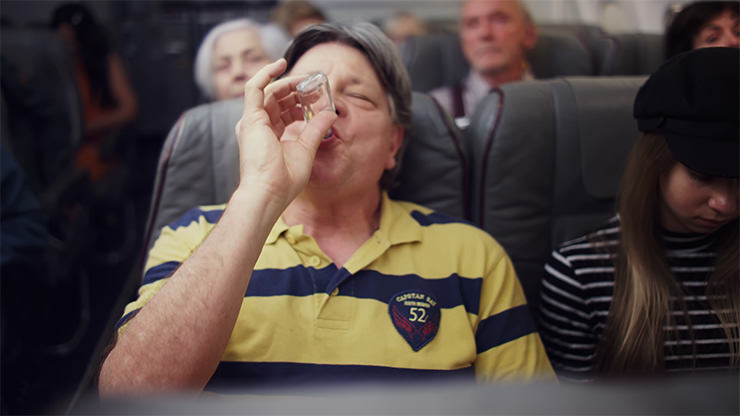
Why do people misbehave on planes?
What turns a seemingly normal person into an unruly passenger at a ten-kilometer height? It seems there are numerous factors making passengers go wild. These are the typical sources of unruly passenger behavior:
-
- People most often misbehave because of alcohol intoxication, but in some cases also drug abuse (trips that get truly trippy). Mixing these with high altitude and cabin pressure does not go well.
- Some passengers could have existing mental health issues which get additionally triggered by the pressure of flying, producing anything from irrational outbursts to full-blown meltdowns.
- There could be a frustration overload when passengers become angry because of the entire flying experience. Stress is formed from endless queues and screening processes, via flight delays and jet lag, to cramped seats, lackluster in-flight entertainment, or other passengers’ behaviors.
We already feel confined in the situation of flying, so when face masks were introduced as a requirement during the pandemic, a surge in unruly aircraft passenger numbers was explained by this frustration too. In 2021, three-quarters of airline passenger incidents were mask-driven tantrums that even toddlers would envy.
In an era when newly imposed rules can be seen as oppression, a small trigger is enough to provoke a radically inappropriate rebellion. The Southwest flight attendant found this out when she lost three teeth in an assault by a passenger who refused to wear her mask properly, put the seat belt on, and stow away her tray table.
This growling man on an American Airlines flight from Los Angeles to Salt Lake City is a poster child for frustration with the pandemic!
From chaos to consequences: What happens to unruly airline passengers?
Dealing with unruly passengers starts with restoring order. While the cabin crew’s first response in de-escalating the situation might be projecting calmness, don’t test the boundaries of this politeness.
You might think a flight attendant’s job is just pouring coffee and distributing pretzels, but you couldn’t be more wrong about it. As everyone’s safety is their main mission, flight attendants undergo intense self-defense training, and are ready to use it when faced with aggressive passengers. You could spend the remaining time of your flight recovering from a stun gun, physically restrained, duct-taped, or even handcuffed.
Depending on the level of one’s action, it is up to a crew member to decide whether they want to report the unruly passenger behavior or let it slide. If they file a report, nothing nice can happen to disruptive passengers.
For a start, flight attendants can remove a difficult passenger from a flight, which typically means a detour from the flight’s regular route and an emergency landing.
After being kicked off the plane, fines for unruly airline passengers can soar up to a jaw-dropping $37,000 per violation.
There could also be criminal charges against unruly passengers. In the States, assaulting a flight attendant is a federal offense that could put the violator behind bars for 20 years.
Airlines could also banish you from the skies. If your passport is hungry for stamps, landing on an unruly aircraft passenger list (so-called no-fly list) should not be on your bucket list.
Check out this passenger on a United Airlines flight from Los Angeles to Boston that won’t be flying again so soon!
The call for action
IATA’s Deputy Director General Conrad Clifford has some choice words for the disruptive passengers on planes. “The increasing trend of unruly passenger incidents is worrying”, he says. “Passengers and crew are entitled to a safe and hassle-free experience on board. There is no excuse for not following the instructions of the crew.”
In response to this unruly epidemic, IATA has outlined a two-pillar strategy to combat the mayhem.
Firstly, governments should have the legal authority to prosecute the actions of unruly passengers, no matter where they come from. Those powers and measures were enabled in the so-called Montreal Protocol 2014, the extension of the Tokyo Convention of 1963 whose loopholes enabled unruly passengers to escape law enforcement. IATA is urging all countries to ratify the MP14, which has been in force since 2020, and until today, covers only a third of international passenger traffic.
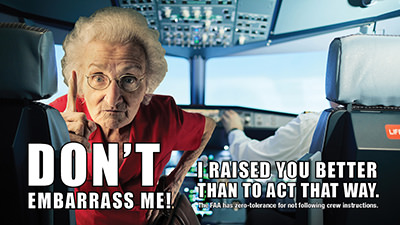
Secondly, guidance and collaboration within the industry are crucial to prevent and de-escalate incidents. That should include collaboration with industry partners (for instance, airport bars and duty-free shops), sharing best practices, but also awareness-raising campaigns that should show the consequences of bad behavior on planes.
For instance, in the US, that is the job of the Federal Aviation Administration. The FAA‘s unruly passenger policy is one of zero tolerance. Their key messages are that behaving dangerously is costly and that unsafe behavior doesn’t fly. In 2021, they used memes to promote the concept.
The European Union Aviation Safety Agency (EASA) launched the #notonmyflight campaign in 2019, and these days they started addressing unruly plane passengers through the Fly Right This Summer campaign. Their mantras are “Be Polite” and “Don’t Fight”, where among other things, passengers are instructed to use magic words such as ‘please’ and ‘thank you’.
Check out other post-pandemic trends in the aviation industry!
Unruly aircraft passenger epidemic – Conclusion
The unruly passengers in the post-pandemic world have become turbulence that cannot be ignored. The aviation industry is not taking the airborne circus lightly. They are eager to deal with sky-bound troublemakers.
But can FAA memes and EASA’s politeness school discourage people from becoming unruly passengers on airlines? Maybe, if students were kindergarten kids. It seems to me that the industry is scratching the surface of a much deeper societal problem.
We see people causing trouble in overcrowded tourist destinations, taking inappropriate pictures on graveyards, and misbehaving anywhere from public statues to gallery exhibitions. In the self-centered world where we starve for attention and our own importance, whether we fight for the plane seat or send the planes to fight another country, it’s not functional just to tell people “Oh, please don’t leave your mark like that”.
Do we have the right systems in place to detect, prosecute and blacklist unruly passengers?
The cultural change we expect reminds of Japan. But it’s a society where order and politeness are ingrained from an early age, and a strict system is in place for mature offenders. When teaching grown-up passengers that politeness is nice, Western systems might be decades late. When punishing them with fines, the same systems might not be strict enough.
“No one wants to stop people from having a good time when they go on holiday”, IATA’s Clifford says. “But we all have a responsibility to behave with respect for other passengers and the crew. For the sake of the majority, we make no apology for seeking to crack down on the bad behavior of a tiny number of travelers who can make a flight very uncomfortable for everyone else.”
We all understand that unruly passengers on airplanes are unwanted. But whether we have the right systems to effectively detect them, properly prosecute them, and blacklist them from flying again, remains up in the air.
A threat of a five-year ban on a certain airline might not be enough to restrain the rudest and most obnoxious airline passengers from producing air rage incidents.
Have you ever witnessed an unruly aircraft passenger?
Tell us about your experience in the comments, and pin the article for later!
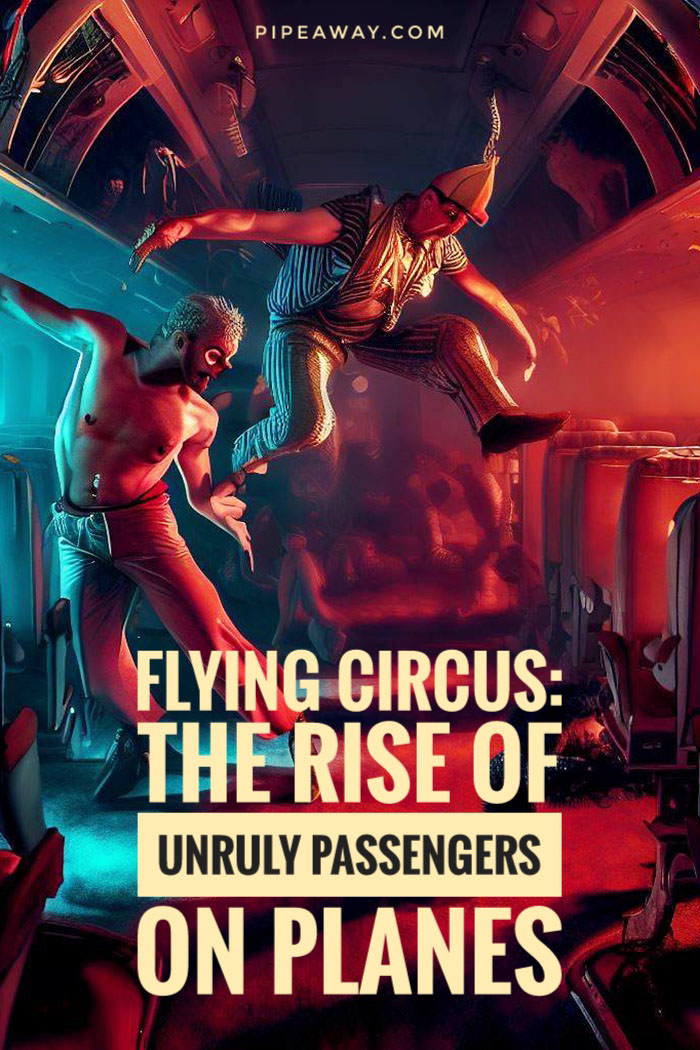

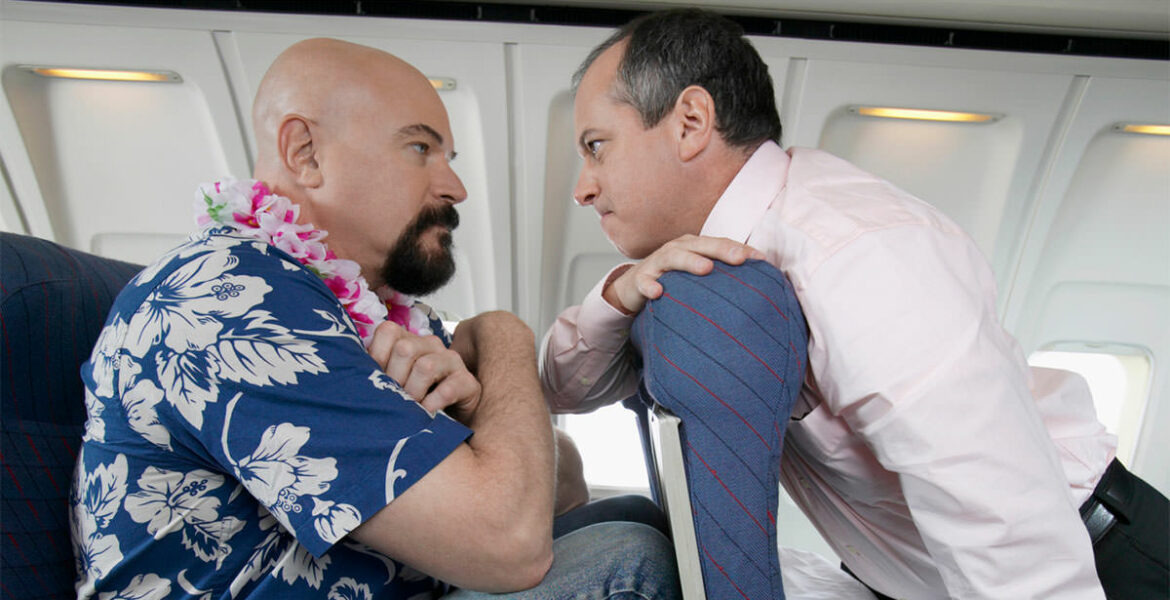
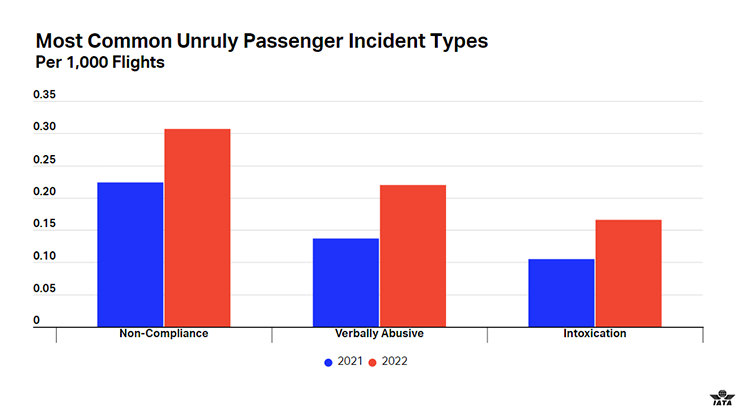


It’s crazy, people just don’t know how to act. Somewhere along the way common decency and the ability to be out in public was lost and now everyone is offended, feel disrespected, entitled, just don’t know how to interact with other people. We need Mrs Blythe, my 1st grade teacher who would rap you on the knuckles with a ruler every time you started to act like an idiot.
Hey Bob!
Totally get what you’re saying. It seems like common decency took an extended vacation while we weren’t looking. Maybe we should send out a search party?
Mrs. Blythe certainly seems to be the ruler-wielding enforcer of manners! But maybe we could also just launch a refresher course on basic human interaction?
Thanks for sharing your thoughts, Bob!
Here’s to a future filled with less idiocy!
I feel alcohol should be banned in airports and planes. They want to drink then drive!
Oh that’s correct; illegal. So should it be in airports and planes. Those people are hurting innocent people!
That goes for drugs. When go through TSA for weapons maybe some one can invent scanning at same time for drugs in the system of the person.
Hey Becky!
Thanks for sharing your thoughts on this hot topic. It’s a complex issue, isn’t it?
The debate around alcohol on planes can definitely stir up some strong opinions. While some enjoy a tipple to take the edge off flying, others think it’s best to steer clear of the beverage cart altogether.
Now, as for the safety concerns, you’ve got a point there. Drinking and driving, whether on land or in the air, is never a good combo. Safety should always be a top priority! And luckily, we can at least count on sober pilots!
As for scanning for drugs at TSA, it’s an interesting idea, but very futuristic, and probably raising many privacy concerns. If only TSA agents could have X-ray vision and sniff out the consumers 🙂 But many passengers would find real drug testing invasive, time-consuming and probably not cost-effective.
Ultimately, it’s all about finding a balance. Let’s hope the airlines and authorities continue to take safety seriously and work towards creating a safer and more pleasant flying experience for everyone.
Thanks for chiming in, Becky! Your thoughts are like fuel for in-flight debates.
Safe travels!